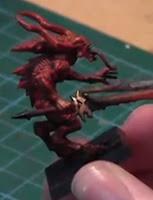 Precisamente ha sido él quien me ha recordado que le parecen muy bien los tutoriales, algunos de los cuales son para sus amigos, pero que tengo un poco olvidada la pintura de su ejército. Esto no es del todo cierto, pero siempre hay una parte de verdad. Por no entrar en polémicas también le voy a satisfacer a él aunque está técnica y forma de pintar ya la tiene superada.
Precisamente ha sido él quien me ha recordado que le parecen muy bien los tutoriales, algunos de los cuales son para sus amigos, pero que tengo un poco olvidada la pintura de su ejército. Esto no es del todo cierto, pero siempre hay una parte de verdad. Por no entrar en polémicas también le voy a satisfacer a él aunque está técnica y forma de pintar ya la tiene superada.El tutorial de hoy es sobre la pintura de un Desangrador de los Demonios del Caos. Aunque el autor le ha puesto una peana de Warhammer desde lugo valdría para Warhammer 40000 simplemente cambiándole la peana o usando alguna de las técnicas que hay por la red para que puedan usar ambas peanas sin demasiados estropicios.
El autor de este tutorial pinta el Desangrador de una manera simple y rápida y es perfecto para cualquier que quiera tener miniaturas pintads en el tablero de juego rápidamente. En otra ocasión pondré otro vídeo con técnicas un poco más finas.
Pinturas
Las pinturas empleadas han sido:Games Workshop
- Mephiston Red - Mechrite Red
- Nuln Oil - Badab Black
- Evil Sunz Scarlet - Blood Red
- Troll Slayer Orange - Fiery Orange
- Rakarth Flesh - Dheneb Stone
- Xereus Purple - Liche Purple
- Balthasar Gold
- Agrax Earthshade - Devlan Mud
- Gehenna's Gold - Shining Gold
Video Tutorial
Warhammer How To Paint Bloodlettershttp://www.youtube.com/watch?v=NWON4R7De-8
Duración: 8:06
Idioma: Inglés-(\d+)/.exec(entry.id.$t); comment.id = id ? id[2] : null; comment.body = bodyFromEntry(entry); comment.timestamp = Date.parse(entry.published.$t) + ''; if (entry.author & entry.author.constructor === Array) { var auth = entry.author[0]; if (auth) { comment.author = { name: (auth.name ? auth.name.$t : undefined), profileUrl: (auth.uri ? auth.uri.$t : undefined), avatarUrl: (auth.gd$image ? auth.gd$image.src : undefined) }; } } if (entry.link) { if (entry.link[2]) { comment.link = comment.permalink = entry.link[2].href; } if (entry.link[3]) { var pid = /.*comments\/default\/(\d+)\?.*/.exec(entry.link[3].href); if (pid & pid[1]) { comment.parentId = pid[1]; } } } comment.deleteclass = 'item-control blog-admin'; if (entry.gd$extendedProperty) { for (var k in entry.gd$extendedProperty) { if (entry.gd$extendedProperty[k].name == 'blogger.itemClass') { comment.deleteclass += ' ' + entry.gd$extendedProperty[k].value; } else if (entry.gd$extendedProperty[k].name == 'blogger.displayTime') { comment.displayTime = entry.gd$extendedProperty[k].value; } } } comments.push(comment); } } return comments; }; var paginator = function(callback) { if (hasMore()) { var url = config.feed + '?alt=json&v=2&orderby=published&reverse=false&max-results=50'; if (cursor) { url += '&published-min=' + new Date(cursor).toISOString(); } window.bloggercomments = function(data) { var parsed = parse(data); cursor = parsed.length < 50 ? null : parseInt(parsed[parsed.length - 1].timestamp) + 1 callback(parsed); window.bloggercomments = null; } url += '&callback=bloggercomments'; var script = document.createElement('script'); script.type = 'text/javascript'; script.src = url; document.getElementsByTagName('head')[0].appendChild(script); } }; var hasMore = function() { return !!cursor; }; var getMeta = function(key, comment) { if ('iswriter' == key) { var matches = !!comment.author & comment.author.name == config.authorName & comment.author.profileUrl == config.authorUrl; return matches ? 'true' : ''; } else if ('deletelink' == key) { return config.baseUri + '/delete-comment.g?blogID=' + config.blogId + '&postID=' + comment.id; } else if ('deleteclass' == key) { return comment.deleteclass; } return ''; }; var replybox = null; var replyUrlParts = null; var replyParent = undefined; var onReply = function(commentId, domId) { if (replybox == null) { // lazily cache replybox, and adjust to suit this style: replybox = document.getElementById('comment-editor'); if (replybox != null) { replybox.height = '250px'; replybox.style.display = 'block'; replyUrlParts = replybox.src.split('#'); } } if (replybox & (commentId !== replyParent)) { document.getElementById(domId).insertBefore(replybox, null); replybox.src = replyUrlParts[0] + (commentId ? '&parentID=' + commentId : '') + '#' + replyUrlParts[1]; replyParent = commentId; } }; var hash = (window.location.hash || '#').substring(1); var startThread, targetComment; if (/^comment-form_/.test(hash)) { startThread = hash.substring('comment-form_'.length); } else if (/^c[0-9]+$/.test(hash)) { targetComment = hash.substring(1); } // Configure commenting API: var configJso = { 'maxDepth': config.maxThreadDepth }; var provider = { 'id': config.postId, 'data': items, 'loadNext': paginator, 'hasMore': hasMore, 'getMeta': getMeta, 'onReply': onReply, 'rendered': true, 'initComment': targetComment, 'initReplyThread': startThread, 'config': configJso, 'messages': msgs }; var render = function() { if (window.goog & window.goog.comments) { var holder = document.getElementById('comment-holder'); window.goog.comments.render(holder, provider); } }; // render now, or queue to render when library loads: if (window.goog & window.goog.comments) { render(); } else { window.goog = window.goog || {}; window.goog.comments = window.goog.comments || {}; window.goog.comments.loadQueue = window.goog.comments.loadQueue || []; window.goog.comments.loadQueue.push(render); } })(); // ]]>
